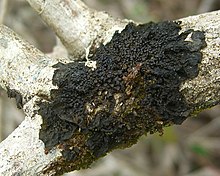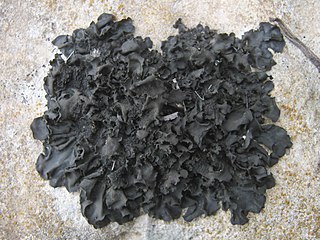
Collema is a genus of lichens in the family Collemataceae. The photobiont is the cyanobacterium genus Nostoc. Species in this genus typically grow on nutrient-rich bark or somewhat siliceous or calcareous rocks in humid environments.

The Arthoniales is the second largest order of mainly crustose lichens, but fruticose lichens are present as well. The order contains around 1500 species, while the largest order with lichenized fungi, the Lecanorales, contains more than 14000 species.

The Arthoniaceae are a family of lichenized, lichenicolous and saprobic fungi in the order Arthoniales. The Arthoniaceae is the largest family of Arthoniales, with around 800 species. Most species in Arthoniaceae belong in Arthonia which is the largest genus with 500 species. The second and third largest genus is Arthothelium with 80 species, and Cryptothecia with 60 species.
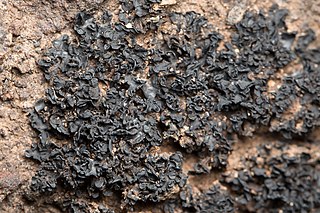
The Lichinaceae are a family of ascomycete fungi. Most species are lichenized with cyanobacteria, and have a distribution largely in temperate regions.

Verrucariaceae is a family of lichens and a few non-lichenised fungi in the order Verrucariales. The lichens have a wide variety of thallus forms, from crustose (crust-like) to foliose (bushy) and squamulose (scaly). Most of them grow on land, some in freshwater and a few in the sea. Many are free-living but there are some species that are parasites on other lichens, while one marine species always lives together with a leafy green alga.
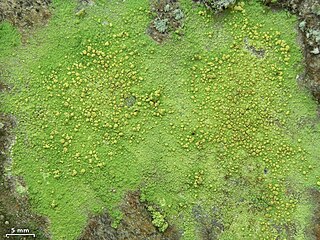
Psilolechia is a genus of four species of crustose lichens. It is the only member of Psilolechiaceae, a family that was created in 2014 to contain this genus.

Roccella is a genus of 23 species of lichens in the family Roccellaceae. The genus was circumscribed by Swiss botanist Augustin Pyramus de Candolle in 1805, with Roccella fuciformis as the type species.
Gallaicolichen is a fungal genus in the division Ascomycota. The relationship of this taxon to other taxa within the division is unknown, and it has not yet been placed with certainty into any class, order, or family. This is a monotypic genus, containing the single species Gallaicolichen pacificus, a foliicolous (leaf-dwelling) lichen.

Leptogium is a genus of lichen-forming fungi in the family Collemataceae. It has about 110 species. Species formerly classified under Leptogium have since been divided among the genera Leptogium, Pseudoleptogium, and Scytinium. Leptogium lichens are predominantly found on tree bark or soil, often among mosses, and sometimes on rocks in moist environments.

Lichen morphology describes the external appearance and structures of a lichen. These can vary considerably from species to species. Lichen growth forms are used to group lichens by "vegetative" thallus types, and forms of "non-vegetative" reproductive parts. Some lichen thalli have the aspect of leaves ; others cover the substrate like a crust, others such as the genus Ramalina adopt shrubby forms, and there are gelatinous lichens such as the genus Collema.

Lecanographaceae is a family of mostly lichens in the order Arthoniales. The family was circumscribed in 2014, prompted by a molecular phylogenetic-based restructuring of the Arthoniales.

Opegraphaceae is a family of lichen-forming and lichenicolous fungi in the order Arthoniales. It was originally proposed by German lichenologist Ernst Stizenberger in 1862. It fell into disuse, but was resurrected in a molecular phylogenetic study of the order Arthoniales published in 2010. It now includes taxa that were previously referred to the family Roccellaceae, its sister group.

Blennothallia is a genus of jelly lichens in the family Collemataceae. It has four species, which collectively have a cosmopolitan distribution.

Scytinium is a genus of lichen-forming fungi in the family Collemataceae. It has 49 species. These lichens are typically found on basic rocks, soil, and trees, occasionally in association with mosses. Despite the morphological and ecological diversity within Scytinium, its species share similar ascospore features, such as shape and septation, as well as a small to medium-sized thallus with at least a partial cortex.

Lathagrium is a genus of lichen-forming fungi in the family Collemataceae. It has 10 species of gelatinous lichens. Species in this genus typically grow on calcareous rocks, often amidst mosses, but can also be found on siliceous or serpentine rocks, mortar, or soil.

Massalongiaceae is a small family of lichen-forming fungi in the order Peltigerales. It has three genera and seven species.
Koerberiaceae is a small family of lichen-forming fungi in the order Peltigerales. It contains 3 genera and 9 species. The family was proposed by Toby Spribille and Lucia Muggia in 2012, after molecular phylogenetic analysis revealed the existence of three lineages of lichen-forming fungi in the suborder Peltigerineae of the order Peltigerales. The lineages represented the genera Steinera, Koerberia, and Vestergrenopsis. The latter genus was later folded into synonymy with Tingiopsidium.
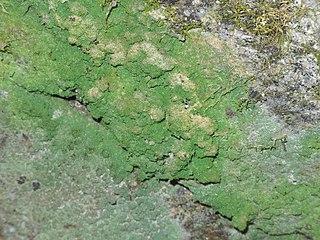
Botryolepraria is a genus of saxicolous (rock-dwelling), byssoid (cottony) lichens of uncertain familial placement in the order Verrucariales. It has two species. Both species grow in damp conditions, such as on cave walls, particularly in areas with minimal light.

Rostania is a genus of lichen-forming fungi in the family Collemataceae. These lichens are primarily found on tree bark, occasionally on wood, with one species known to inhabit soil. The genus is characterized morphologically by having minute thalli made of hyphal tissue without a separate cortex, and the more or less cuboid-shaped ascospores.

The Collematineae are an suborder of rust fungi in the order of Peltigerales in the class Lecanoromycetes.
